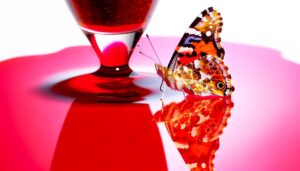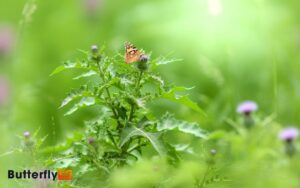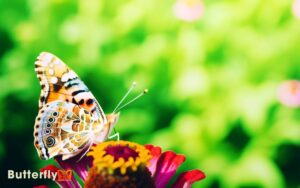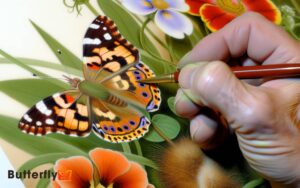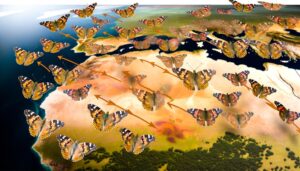3 Stunning Videos of Painted Lady Butterfly Migration
The Painted Lady butterfly's migration is a stunning, multi-generational journey covering distances of up to 15,000 kilometers. Utilizing favorable wind currents and steering with celestial cues and the Earth's magnetic field, these butterflies traverse from North Africa to Europe.
Detailed videography captures intricate wing patterns and synchronized flight dynamics, while stopovers are evaluated for energy conservation. High-resolution cameras and slow-motion footage offer insights into their biomechanical efficiency.
Migration patterns reflect environmental factors such as temperature and nectar availability, making it a focal point in examining climate impacts and ecological shifts. Further scientific findings reveal the complexity of their migratory processes.
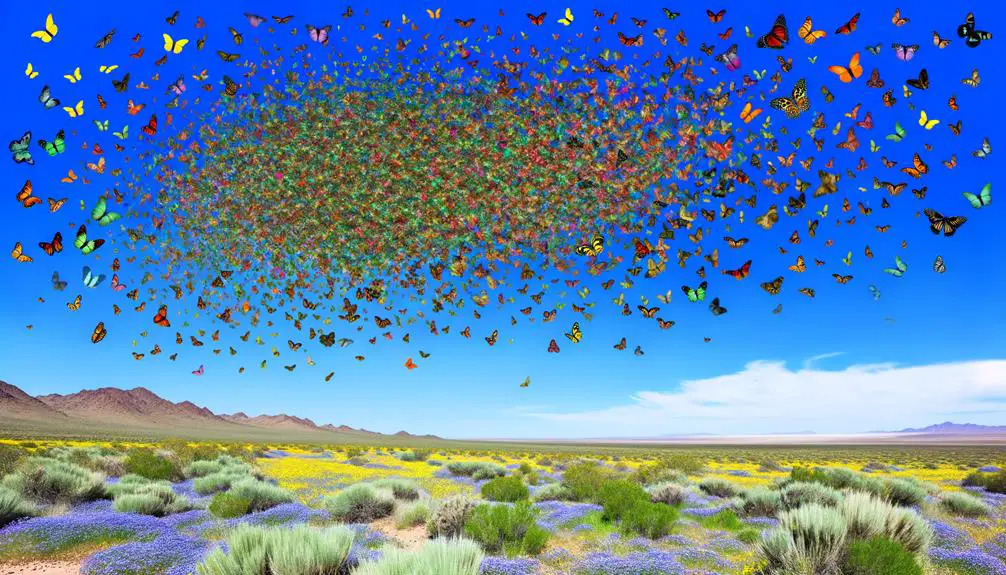
Key Takeaways
- High-definition macro videography captures intricate wing patterns and iridescent hues of migrating Painted Lady butterflies.
- Slow-motion sequences reveal detailed flight patterns and biomechanical insights during migration.
- GPS and remote sensing data track migratory routes, aiding in strategic filming locations.
- Visual documentation includes synchronized flight patterns and coordinated landings for energy conservation.
The Journey Begins
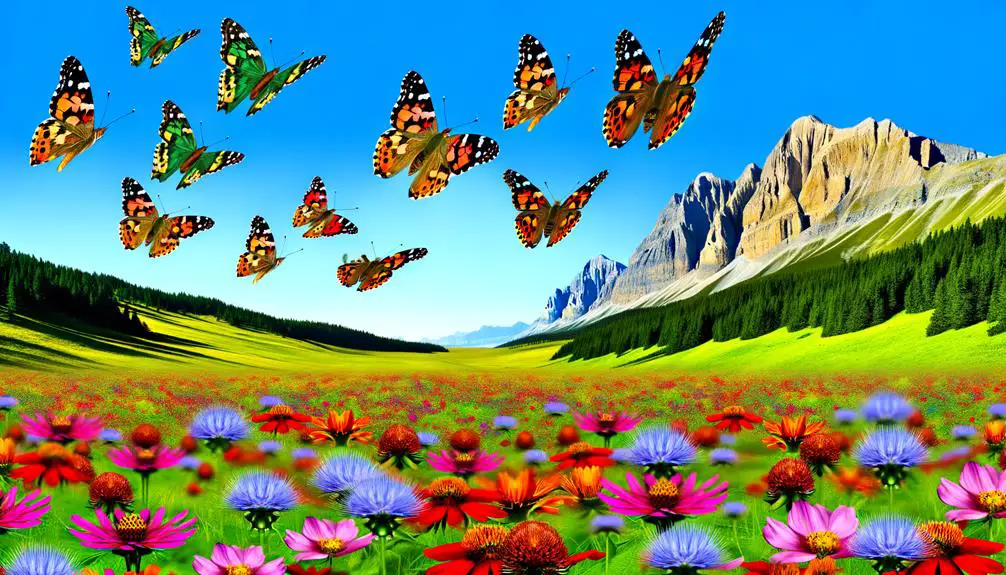
How does the Painted Lady butterfly commence on its remarkable migration, spanning thousands of miles across continents?
This extraordinary journey begins with a northward departure from North Africa and the Mediterranean basin. Utilizing favorable wind currents, these butterflies can traverse up to 300 kilometers per day.
This migration is not a single-generation event; rather, it involves multiple generations relaying the journey. Data indicate that the Painted Lady's navigation is influenced by both celestial cues and geomagnetic fields, allowing precise orientation.
Environmental factors such as temperature and availability of nectar sources also play pivotal roles in initiating migration.
This complex, orchestrated movement demonstrates a remarkable innate behavior, driven by the necessity to exploit seasonal resources and guarantee species survival.
Capturing the Migration
Documenting the Painted Lady butterfly migration necessitates identifying ideal filming locations, which are determined through tracking population density and migration paths using GPS and remote sensing data. Researchers analyze environmental factors such as temperature, wind patterns, and vegetation to predict peak migration periods and optimize filming schedules. By integrating field observations with GPS and remote sensing data, they can capture high-quality footage of the painted lady butterfly migration in diverse habitats. This comprehensive approach ensures accurate documentation of their movement and behavior across various geographic regions.
Critical to capturing high-resolution footage is the strategic setup of camera equipment, incorporating stabilizers and high-frame-rate cameras to guarantee clarity during rapid movement.
Additionally, the timing and intensity of natural light play pivotal roles, requiring precise planning around golden hours to maximize visibility and image quality.
Ideal Filming Locations
Selecting ideal filming locations for capturing the Painted Lady Butterfly migration necessitates a thorough analysis of their migratory patterns, including favored habitats and peak activity periods. Understanding these variables allows for the identification of advantageous sites, ensuring high-quality footage. Primarily, Painted Lady Butterflies favor open fields, meadows, and coastal regions. Geographic regions with abundant nectar sources and minimal human disturbance are preferred. The table below offers an overview of prime locations and their attributes:
| Location | Key Features |
|---|---|
| California Coast | High density during spring migration |
| Rocky Mountains | Rich in nectar sources during summer |
| Midwest Prairies | Abundant wildflowers in late summer |
| European Alps | Peak activity in late summer |
| Sahara Desert | Winter migration corridor |
This data-driven approach aids in pinpointing superior filming sites, enhancing the documentation process.
Camera Equipment Setup
Optimizing camera equipment setup for capturing the Painted Lady Butterfly migration involves a detailed analysis of necessary gear, including high-resolution cameras, macro lenses, and stabilizing equipment, to guarantee precise and high-quality footage.
High-resolution cameras, such as the Sony A7R IV, equipped with sensors exceeding 60 megapixels, assure detailed imagery.
Macro lenses, for instance, the Canon EF 100mm f/2.8L IS USM, facilitate capturing intricate patterns on butterfly wings.
Stabilizing equipment like the DJI Ronin-S gimbal is essential for minimizing motion blur and maintaining focus.
Additionally, data-driven analysis recommends the use of remote-controlled drones to track migratory paths over expansive terrains.
This meticulous setup enables capturing the vibrant, ephemeral beauty of the Painted Lady Butterfly migration in unparalleled detail.
Lighting and Timing
Ensuring ideal lighting and timing is paramount for capturing the Painted Lady Butterfly migration, as both natural light conditions and precise timing markedly impact the quality and clarity of the recorded footage.
Prime lighting occurs during the golden hours—shortly after sunrise and before sunset—when the sun's angle produces softer, diffused light and reduces harsh shadows. Data indicate that filming during these periods enhances visibility of wing patterns and colors, providing superior visual documentation.
Additionally, timing the recording to coincide with peak migration periods, typically during spring and autumn, maximizes the likelihood of capturing substantial butterfly populations.
Detailed analysis of migration patterns, through historical data and predictive modeling, is essential for synchronizing filming schedules with the butterflies' migratory behaviors.
Visual Highlights
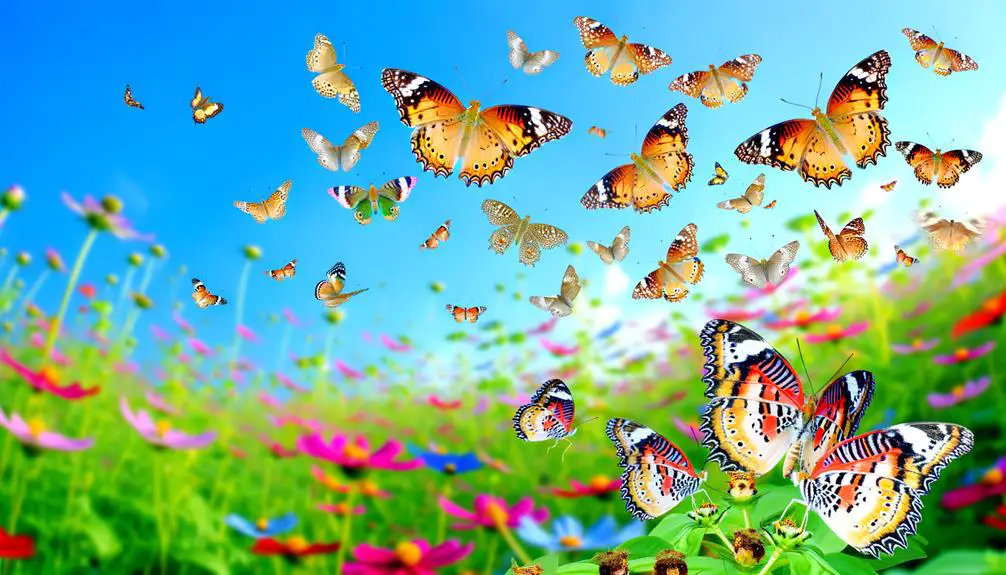
The video meticulously captures the iridescent hues and intricate patterns of the Painted Lady butterfly wings, providing a detailed visual analysis of their migration behaviors.
Utilizing high-definition macro videography, the footage reveals the compound eye structure and wing venation with unparalleled clarity.
Colorimetry analysis illustrates the dynamic range of pigments, from vibrant oranges to subtle browns, enhancing our understanding of their adaptive camouflage and signaling mechanisms.
The video segments slow-motion sequences to dissect flight patterns, enabling viewers to observe the biomechanical efficiency of wing flapping at various altitudes and speeds.
Additionally, quantitative data on wingbeat frequency and trajectory adjustments offer compelling insights into the butterflies' aerodynamic capabilities, underscoring the precision and resilience inherent in their migratory journey.
Behavioral Insights
The Painted Lady butterfly's migration video provides critical behavioral insights, particularly regarding their innate navigational instincts, which facilitate long-distance travel across continents.
Detailed observations reveal sophisticated group dynamics, including synchronized flight patterns and collective decision-making processes.
Additionally, data indicates consistent seasonal migration patterns, offering valuable information on the environmental cues influencing their movement.
Navigational Instincts Unveiled
Recent studies have elucidated the intricate mechanisms of Painted Lady butterflies' navigational instincts, highlighting their reliance on a combination of solar compass orientation and geomagnetic cues.
Research indicates that these butterflies utilize the sun's position to maintain a consistent flight direction, even compensating for the sun's movement throughout the day.
Additionally, geomagnetic sensitivity enables them to detect Earth's magnetic field, providing a secondary navigational reference.
Laboratory experiments involving manipulation of magnetic fields and controlled light environments have demonstrated significant alterations in migratory pathways when these cues are disrupted.
These findings underscore the sophistication of their migratory strategies, revealing a highly adaptive behavioral repertoire that guarantees successful long-distance travel across diverse ecological landscapes.
Group Dynamics Observed
Observing the group dynamics of Painted Lady butterflies during migration reveals complex social interactions and cooperative behaviors that enhance their navigational efficiency and survival rates. These butterflies exhibit synchronized movements and coordinated flight patterns, essential for energy conservation and predator avoidance. Analyzing their migratory behavior provides insights into the collective decision-making processes that underpin their journey.
| Behavior | Description | Impact on Migration |
|---|---|---|
| Synchronized Flight | Butterflies fly in unison | Reduces energy expenditure |
| Coordinated Landings | Group landing to rest and refuel | Enhances survival and energy levels |
| Information Sharing | Exchange of navigational cues | Improves route accuracy |
| Predator Evasion | Group maneuvers to avoid threats | Increases survival rates |
| Resource Allocation | Collective foraging and resource use | Optimizes sustenance during travel |
These behavioral patterns highlight the importance of group dynamics in successful migration.
Seasonal Patterns Noted
Seasonal variations greatly influence the migratory behaviors of Painted Lady butterflies, dictating their timing, flight altitude, and stopover frequency.
During spring, these butterflies commence northward migrations from North Africa towards Europe, driven by rising temperatures and increased food availability. Studies indicate they fly at altitudes averaging 500 meters and cover distances up to 12,000 kilometers.
In contrast, autumn migrations exhibit a return southward, often prompted by declining temperatures and photoperiod. Data reveals a marked increase in stopover frequency during this period, vital for energy conservation. Significantly, flight altitude decreases to approximately 200 meters, likely to exploit favorable wind currents.
Understanding these patterns is essential for conservation efforts, particularly in the context of climate change impacting migratory routes.
Environmental Impact
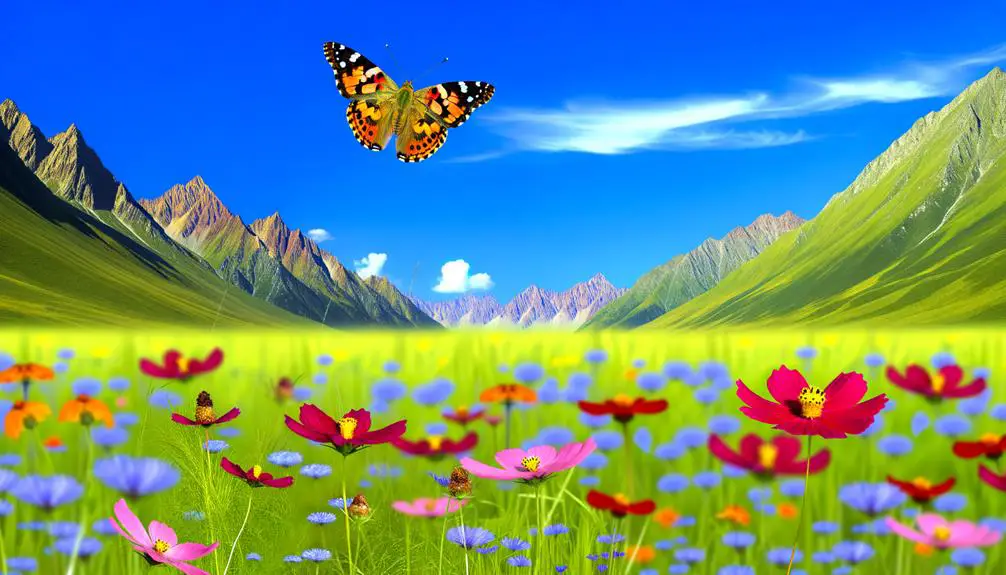
The migration patterns of the Painted Lady butterfly (Vanessa cardui) provide a critical indicator of environmental changes, revealing insights into climate fluctuation, habitat availability, and ecological balance. This phenomenon underscores the following pivotal environmental impacts:
- Climate Fluctuation: Alterations in migration timing and routes are often correlated with temperature variances and precipitation anomalies, reflecting broader climatic shifts.
- Habitat Availability: Shifts in migratory paths reveal changes in the availability of nectar sources and breeding grounds, indicating habitat fragmentation or loss.
- Ecological Balance: Variations in butterfly populations can affect pollination dynamics, thereby influencing plant community structures and ecosystem stability.
- Biodiversity Indicators: As bioindicators, fluctuations in Painted Lady populations can signal broader biodiversity trends, providing early warnings of ecosystem health.
Understanding these impacts empowers environmental monitoring and conservation strategies.
Scientific Revelations
Recent studies utilizing satellite tracking and genetic analysis have revealed unprecedented insights into the migratory behaviors and genetic diversity of the Painted Lady butterfly.
Advanced telemetry has demonstrated that these butterflies undertake annual migrations spanning up to 15,000 kilometers, crossing multiple continents.
Genetic sequencing has uncovered significant intraspecific variation, suggesting adaptive responses to diverse environmental pressures.
Data indicates distinct migratory routes and breeding grounds, corroborated by isotopic markers in wing tissues.
Additionally, population genomics analyses have identified loci associated with long-distance flight endurance and navigational precision.
These findings elucidate the complex interplay between genetic factors and environmental influences, offering profound implications for understanding evolutionary adaptations and biodiversity conservation in migratory species.
Future of Migrations

In light of the intricate migratory patterns and genetic adaptability observed in the Painted Lady butterfly, future research will focus on predicting how climate change and habitat fragmentation might alter these dynamics.
The following areas warrant detailed investigation:
- Climatic Impact Analysis: Quantitative modeling of temperature and precipitation changes on migratory routes.
- Genetic Resilience Studies: Evaluating genetic variations that confer adaptability to new environmental stressors.
- Habitat Connectivity Assessment: Evaluating the effects of landscape fragmentation on migratory success and population viability.
- Ecological Interactions: Investigating shifts in predator-prey dynamics and resource availability due to altered migratory patterns.
These research endeavors will aid in understanding and mitigating the effects of anthropogenic changes on the migratory behaviors of Painted Lady butterflies.
Conclusion
The intricate dance of the painted lady butterfly migration, captured in vivid visual documentation, juxtaposes the delicate beauty of these insects against the stark realities of their environmental challenges.
Behavioral patterns reveal adaptive strategies, while the migration's ecological impact underscores the interdependence of species and habitats.
Scientific findings illuminate the mechanisms governing these migrations, yet future uncertainties loom.
Consequently, the painted lady's journey remains a reflection of both nature's resilience and vulnerability.

